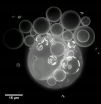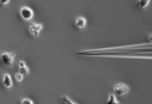(Press-News.org) A self-driven reaction can assemble phospholipid membranes like those that enclose cells, a team of chemists at the University of California, San Diego, reports in Angewandte Chemie.
All living cells use membranes to define physical boundaries and control the movement of biomolecules, and movement of molecules through membranes is a primary means of sending signals to and from cells.
Neal Devaraj, a chemistry and biochemistry professor at UC San Diego, leads a research team that develops and explores new reactions that can trigger the formation of membranes, particularly the spheres that characterize membranes that enclose vesicles and cells.
The new process they have just described is specific and non-toxic, and can be used in the presence of biomolecules one might want to study within artificial cells. The technique could also be used to assemble packets for drug delivery.
Natural cells use enzymes to catalyze the biochemical reactions that manufacture their membranes from thioester precursors, but in this case Devaraj's team was able to get membranes to assemble spontaneously, without enzymes, through a process called native chemical ligation.
"This is the first report to my knowledge of nonenzymatically forming phospholipid membranes from thioester precursors," Devaraj said. "This mimics the membrane-protein-catalyzed assembly of phospholipids in live cells, which also uses long-chain thioesters as precursors."
INFORMATION:
Co-authors include postdoctoral researcher Roberto Brea and graduate student Christian Cole. This work was funded by a grant through the MURI program, U.S. Army Research Office and the National Science Foundation. Brea is a Cross-Disciplinary Fellow in the Human Frontier Science Program. Cole is supported through a National Institute of General Medical Sciences training grant.
Cell membranes self-assemble
2014-10-27
ELSE PRESS RELEASES FROM THIS DATE:
First time-lapse images of exploding fireball from a 'nova' star
2014-10-27
Astronomers at the University of Sydney are part of a team that has taken images of the thermonuclear fireball from a 'nova star' for the first time tracking the explosion as it expands.
The research is published in the journal Nature today.
The eruption occurred last year in the constellation of Delphinus (the Dolphin).
Professor Peter Tuthill, from the University's Sydney Institute for Astronomy and co-author on the paper says astronomers are excited about the achievement:
"Although novae often play second fiddle in the popular imagination to their more famous ...
Tremendously bright pulsar may be 1 of many
2014-10-27
Recently, a team of astronomers reported discovering a pulsating star that appears to shine with the energy of 10 million suns. The find, which was announced in Nature, is the brightest pulsar – a type of rotating neutron star that emits a bright beam of energy that regularly sweeps past Earth like a lighthouse beam – ever seen. But what are the odds finding another one?
According to one of the paper's authors, chances are good now that they know what to look for.
Professor Deepto Chakrabarty of the Kavli Institute for Astrophysics and Space Research at ...
Emergent behavior lets bubbles 'sense' environment
2014-10-27
VIDEO:
A collection of artificial lipid bubbles cycle through changes in their membranes as the surrounding environment changes. As the osmotic potential changes, different lipids in the membranes form patchy domains...
Click here for more information.
Tiny, soapy bubbles can reorganize their membranes to let material flow in and out in response to the surrounding environment, according to new work carried out in an international collaboration by biomedical engineers at the ...
One drop will do: UBC researchers develop simple new test for vitamin B12 deficiency
2014-10-27
Researchers at the University of British Columbia have developed a novel method to test for vitamin B12 deficiency that is sensitive enough to work on anyone, including newborn babies and large swaths of the general population.
Vitamin B12 deficiency can be tested with a single drop of blood collected from a finger prick, then blotted and dried overnight on a card consisting of filter paper. The UBC study made dried blood spot card analysis sensitive enough to measure the amount of methylmalonic acid (MMA), an indicator of a person's B12 level.
"This minimally invasive ...
International research group publishes updated criteria for diagnosing multiple myeloma
2014-10-27
ROCHESTER, Minn. –The International Myeloma Working Group (IMWG) today announced that it has updated the criteria for diagnosing multiple myeloma. A paper outlining the new criteria was published in the journal Lancet Oncology. Multiple myeloma is a blood cancer that forms in a type of white blood cell called a plasma cell.
"Our group, which includes more than 180 myeloma researchers worldwide, has updated the definition of multiple myeloma for diagnostic purposes to include validated biomarkers in addition to the current clinical symptoms used for diagnosis which ...
Diabetes patients report better outcomes with improved physician accessibility
2014-10-27
LOS ANGELES — A new model of delivering primary care studied by Keck Medicine of the University of Southern California (USC) researchers has the potential to improve the health of patients with type 2 diabetes.
The model encourages doctors to be more of a "medical home" for their patients by being accessible to patients in person and by phone, developing good ongoing relationships with their patients, and being more proactive in helping coordinate care for patients with difficult health problems.
Gregory Stevens, Ph.D., associate professor of family medicine ...
Clinical results indicate vaccine candidate highly efficacious against bacterial diarrhea
2014-10-27
Washington, DC, October 27, 2014—New results from a safety and immunogenicity study, which included a challenge phase to test efficacy, indicate that a live attenuated enterotoxigenic Escherichia coli (ETEC) vaccine candidate, given in combination with a novel adjuvant, provided significant protection against disease. This represents the first efficacy data for this vaccine/adjuvant combination, which was 58.5 percent efficacious in protecting against diarrhea of any severity using a highly rigorous ETEC human challenge model. The vaccine/adjuvant combination was ...
How cells know which way to go
2014-10-27
VIDEO:
In this video, lab-grown human leukemia cells move toward a pipette tip holding an attractive chemical.
Click here for more information.
Amoebas aren't the only cells that crawl: Movement is crucial to development, wound healing and immune response in animals, not to mention cancer metastasis. In two new studies from Johns Hopkins, researchers answer long-standing questions about how complex cells sense the chemical trails that show them where to go — and the ...
The Ebola epidemic: Is there a way out?
2014-10-27
Berlin, 27 October 2014. Not everyone who contracts the Ebola virus dies, the survival rate is around 30% suggesting that some kind of immunity to the disease is possible. Experimental treatments and vaccines against Ebola exist but have not yet been tested in large groups for safety and efficacy (phase 2 trials).
The International Union of Immunology Societies (IUIS) published a statement today in its official journal, Frontiers in Immunology calling for urgent and adequate funding of vaccine candidates in clinical trials and speedy implementation of immunisation in ...
Chest radiation to treat childhood cancer increases patients' risk of breast cancer
2014-10-27
A new study has found that patients who received chest radiation for Wilms tumor, a rare childhood cancer, face an increased risk of developing breast cancer later in life due to their radiation exposure. Published early online in CANCER, a peer-reviewed journal of the American Cancer Society, the findings suggest that cancer screening guidelines might be re-evaluated to facilitate the early diagnosis and prompt treatment of breast cancer among Wilms tumor survivors.
Wilms tumor is a rare childhood kidney cancer that can spread to the lungs. When this spread occurs, patients ...


